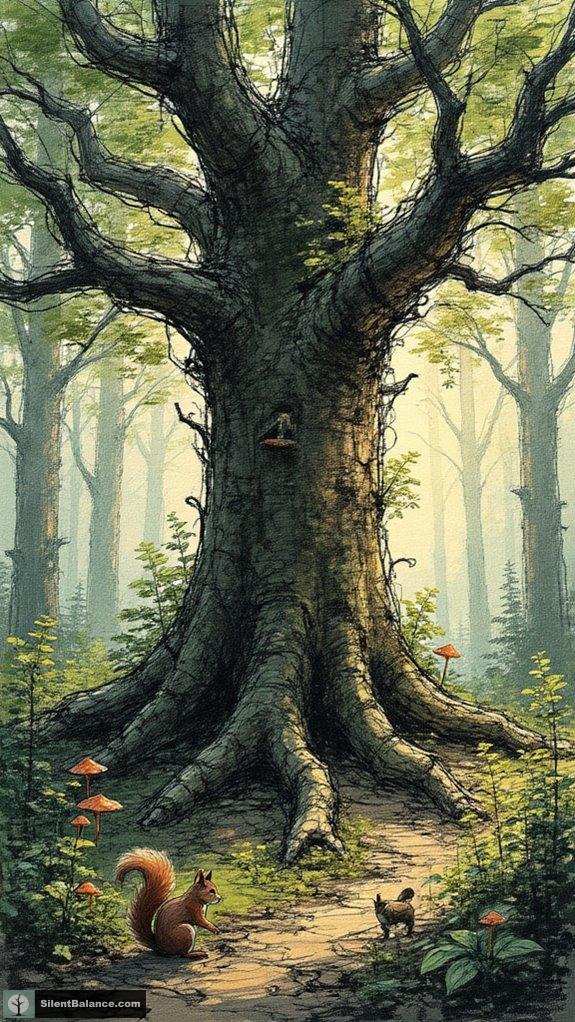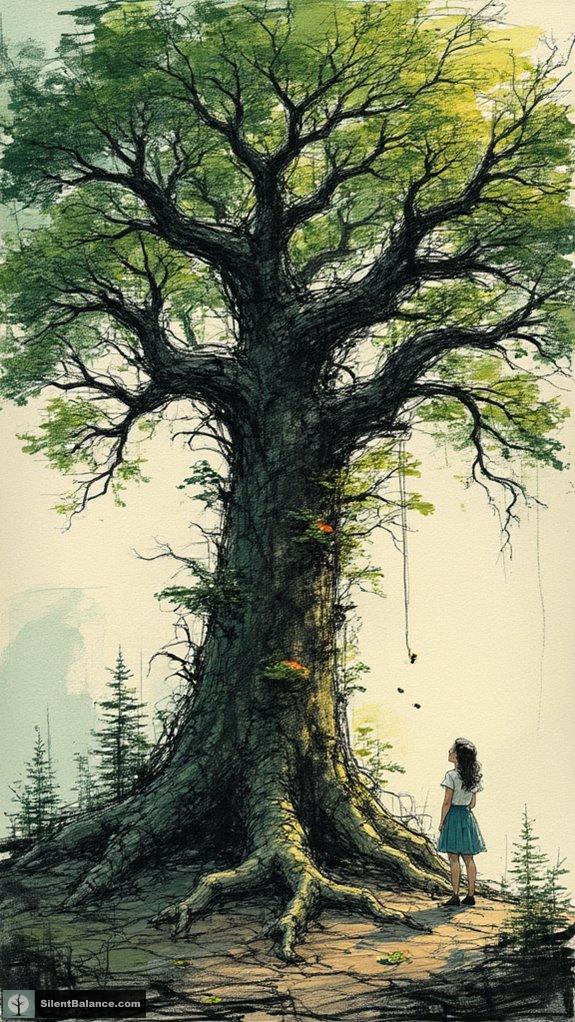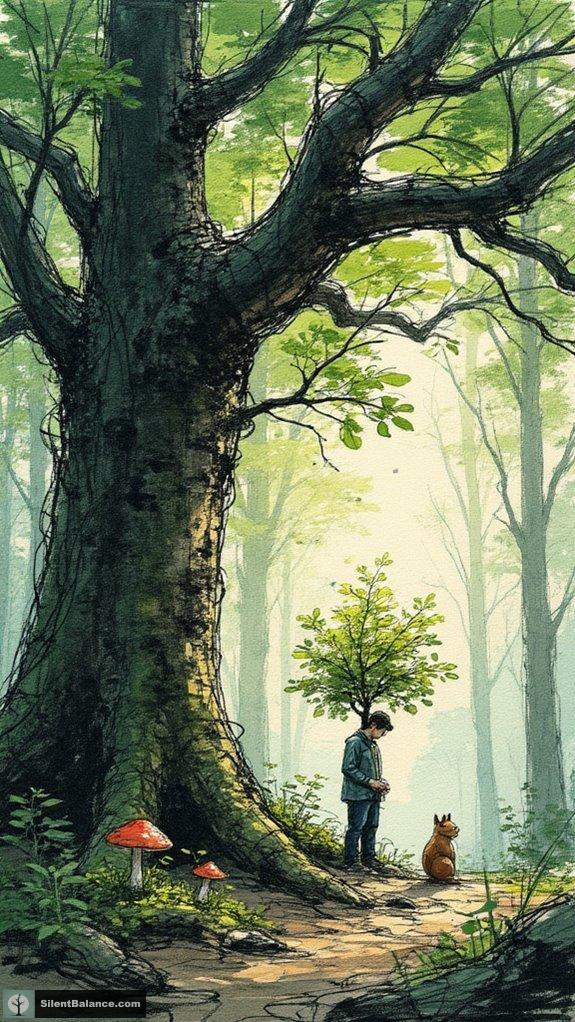Trees: The Unseen Family Ties in the Forest
Have you ever wondered how trees support one another? It’s like family reunions underground!
I recall wandering through a lush forest, feeling a connection to the towering trees. It struck me how they symbolize strength, unity, and resilience. Our blog, Silent Balance, dives deep into these themes, exploring how kin recognition fuels their survival.
Through intricate mycorrhizal networks, trees barter nutrients and send distress signals, ensuring their family thrives. Mother trees embrace their seedlings, showcasing the power of kinship. Every root intertwines with purpose!
Once, I witnessed a fallen tree. Instead of withering, neighboring trees adapted, sharing resources to stand strong together. It was a heartwarming reminder of their bond, echoing a larger truth we often overlook. Trees teach us about community and connection in ways we can strive to emulate.
Quick Takeaways
- Kin recognition among trees promotes cooperation, improving resource sharing and enhancing forest biodiversity.
- Mycorrhizal networks facilitate nutrient exchange, allowing trees to communicate and support kin through chemical signals.
- Mother trees play a crucial role in supporting seedlings and promoting genetic diversity through cooperative resource distribution.
- Resource sharing among kin reduces competition, increasing the survival rates and resilience of trees in the ecosystem.
- Effective kin discrimination enables trees to allocate resources strategically, benefiting their genetic relatives over unrelated individuals.
The Concept of Kin Recognition in Forest Ecosystems

When you step into a lush forest, it’s easy to overlook the complex relationships happening beneath the surface, but kin recognition among plants is a game-changer in the natural world. Imagine plants buddying up with their genetic relatives, making smart choices to grow together and thrive. They’re not just in it for themselves—oh no! Species like *Impatiens pallida* even shift their roots to be more efficient with resources. How cool is that? These clever connections influence everything from competition levels to overall forest biodiversity, enhancing resource availability through common mycorrhizal networks. Additionally, these mycorrhizal networks facilitate nutrient exchange among trees, allowing them to support their kin in times of need.
Mechanisms of Communication Among Mother Trees

Through mycorrhizal connections, they send and receive crucial chemical signals, kinda like texting other trees! They’re not just gossiping; they actually share nutrients and hormones, helping young seedlings thrive until they’re ready to stand on their own. Additionally, these underground networks create a mycorrhizal web that enhances the resilience of the entire forest ecosystem. And guess what? Mother Trees even distinguish kin from strangers through specific signals. This means they lavish more resources on relatives, ensuring the survival of their tree fam. Studies show that Mother Trees preferentially support kin, leading to greater success for seedlings connected to their networks.
Cooperative Resource Allocation Strategies

In the world of forestry, embracing cooperative resource allocation strategies isn’t just smart—it’s a game changer.
Consider it: when you join forces with fellow forest producers, you’re revealing potential like never before!
- Cost Reduction: Cooperatives let small producers pool resources for essential supplies.
- Increased Bargaining Power: Together, you can score lower prices on everything from fuel to saw chains.
- Optimized Resource Management: Coordinated plans bring multiple stakeholders together, enhancing sustainability.
Isn’t it time to maximize your resources while minimizing costs?
Envision sharing costly equipment—like log skidders and sawmills—without breaking the bank!
These strategies not only build community but also strengthen your market position.
So, why not take the leap and collaborate?
You’ll be surprised by how powerful teamwork can be!
The Role of Root Interactions in Nutrient Sharing

Just as cooperative strategies amplify the strength of forest producers, root interactions among trees play an essential role in nutrient sharing.
Ever seen trees linking up underground? Those fine roots do more than dig for water. They connect with mycorrhizal fungi, which act like a nutrient highway, transferring essential resources between trees, sometimes even across species! The interaction of fine roots with moisture conditions can significantly influence their ability to tap deeper soils for essential resources.
Check out this table for a quick breakdown:
| Interaction Type | Function | Importance |
|---|---|---|
| Fine Roots | Absorb nutrients and water | Control nutrient uptake |
| Mycorrhizal Fungi | Facilitate nutrient transfer | Enable sharing among trees |
| Root Grafting | Directly connect roots for resource sharing | Boost cooperative distribution |
Impact on Forest Diversity and Stability

While you might think of forests as a wild, untamed art gallery, they’re actually complex communities where kin recognition plays a significant role in shaping diversity and stability.
- Kin networks boost survival rates by promoting cooperation among related trees.
- Resource sharing helps young or damaged trees bounce back, supporting community stability. This kin recognition among trees allows for strategic sharing of resources, enhancing their chances of survival in challenging environments.
- Genetic clustering might limit diversity but also enhances group fitness during stress.
Ever thought about how similar trees can either work together like a family or step on each other’s toes?
Kin recognition can enhance resilience, making the forest stronger. By understanding these dynamics, you can appreciate how forests dance through their own unique rhythms, balancing cooperation with competition, showcasing nature’s artistry in survival.
Evolutionary Advantages of Kin Discrimination

Kin discrimination isn’t just a fancy term tossed around in ecology; it’s a survival tactic that plants and animals use to sort out their own from the crowd.
By recognizing kin, they can direct cooperation toward relatives, improving survival odds.
Imagine this: if you’re sharing resources with family, you’re less likely to face fierce competition. Pretty savvy, right?
This kin selection not only boosts your inclusive fitness but also encourages altruistic behaviors, making life a whole lot easier in the forest.
Ever wonder how this all works? Various molecular signals help organisms identify their kin, making sure they invest their resources wisely in those who share common genes. Kin recognition mechanisms are vital for ensuring that the benefits of cooperation are directed toward relatives.
Future Research Directions in Tree Communication

As we explore the future of research on tree communication, it’s clear that the forests are buzzing with more than just the sound of rustling leaves.
Envision the untapped potential of understanding how trees truly connect!
- Fungal networks that share resources and signals
- Anticipating environmental changes through bioelectrical syncs
- AI translating plant signals for human understanding
Picture this: woods filled with wise, interconnected trees sharing secrets beneath our feet.
Your curiosity fuels the need to clarify what purpose these networks serve. Are they just passing notes, or is there a deeper bond?
Future studies could reveal forest resilience secrets, helping us create better conservation efforts.
Science of Mother Trees

When you think about the role of Mother Trees in the forest, you’re stepping into a world where communication and support are key to ecosystem health.
These ancient giants don’t just stand tall; they thrive on a complex network of connections, sharing essential nutrients like a well-meaning parent offering a snack to their kids.
Role in Ecosystem Health
Have you ever wondered how the ancient giants of the forest—those mother trees—play an essential part in keeping our ecosystems in tip-top shape?
Here’s how they flex their green muscles:
- Nutrient Powerhouses: Mother trees connect to a mycorrhizal network, dishing out nutrients and carbon to seedlings and their tree buddies.
- Biodiversity Boosters: By hosting various organisms, they maintain genetic diversity important for forest adaptability, ensuring we keep that ecological balance.
- Resilience Champions: They protect fragile seedlings, creating little safe zones that help forests bounce back from environmental shocks.
Communication and Signaling
Communication in forests might sound like a mystical concept, but it’s all rooted in science—literally!
Mother Trees connect through Mycorrhizal Fungal Networks, sharing wisdom, warnings, and resources like seasoned friends in a bustling tattoo parlor.
Envision those fungal hyphae as a natural Wi-Fi, buzzing with chemical signals that help trees alert each other to threats like pests or drought.
It’s like a family reunion where trees flex their genetic ties, sending nutrients preferentially to kin seedlings.
Visualize this: your favorite tattoo artist giving you exclusive ink tips because you share a history.
Trees do the same! They foster survival, proving that kinship in the wild is as significant as it’s in our inked circles, showing love and solidarity in their leafy haven.
Nutrient Exchange Mechanisms
Connecting through the underground world of mycorrhizal fungal networks, Mother Trees orchestrate a nutrient exchange that’s as dynamic as a bustling tattoo parlor, where seasoned artists share their tricks of the trade.
You’re probably wondering, how does this all work? Here’s the scoop:
- Mother Trees identify their own seedlings with biochemical signals, like an artist recognizing their original tattoo client.
- They channel resources through a complex network, handing out carbon, nitrogen, and more—like freebies at a tattoo expo.
- This nutrient flow not only boosts seedling growth but also promotes forest resilience, proving kinship isn’t just a family affair.
Mother Trees Kin Recognition and Resource Sharing

Envision wandering through a lush forest, where tall Mother Trees stand like wise guardians, silently watching over their kin.
These majestic elders aren’t just there for the vibes; they engage in secret conversations through roots and mycorrhizal fungi. Ever heard of volatile compounds and neurotransmitter-like signals? Yup, the trees send messages directly to their kin, sharing resources like a true family would.
When you spot a young sapling next to a Mother Tree, know it’s got an edge—she’s pouring carbon and nutrients into its life. It’s like she’s got a tattoo of ‘I got your back’ inked right into her bark!
Questions and Answers
How Do Kin Recognition Mechanisms Vary Across Different Plant Species?
You might be surprised how kin recognition can vibe differently across plant species.
Some have unique root exudates that signal to their kin, like calling your homies for backup at a tattoo convention. Others don’t always distinguish between self and kin, blurring those lines.
It’s a wild scene! For instance, certain plants chill with fewer roots when around relatives, instead of flexing hard against them.
Ain’t that a novel way to boost family bonds?
What Are the Implications for Forest Ecosystem Management?
When you think about forest ecosystem management, consider how preserving relationships can boost resilience.
By protecting mother trees and related kin clusters, you’re fundamentally keeping the family tree strong. This promotes healthy resource sharing, enhancing survival rates and even helping during disturbances like droughts.
Doesn’t it feel good to know that by managing forest kinship wisely, you’re nurturing a tougher, more vibrant ecosystem? It’s like giving the forest a fighting chance, right?
How Can Kin Recognition Influence Tree Survival Rates?
You might be surprised, but kin recognition can really boost tree survival rates.
When trees recognize their relatives, they often play nice, minimizing root competition and optimizing resource sharing.
Envision trees forming a tribe, cooperating to secure water and nutrients. This means less stress during tough times, like droughts.
Plus, when kin cluster together, they create a supportive vibe, ensuring their collective survival and thriving.
Isn’t that a wild way nature adapts and survives?
What Role Do Pathogens Play in Kin Recognition Among Trees?
Envision a crew of trees, standing tall, reading the vibes of their soil. Pathogens play an essential role in this underground drama. They tweak root exudates, your plant pals use to distinguish kin from impostors.
When pathogens roll in, they signal the need for teamwork, enhancing cooperation. Think of it as a natural tattoo—each tree’s chemical ink tells relatives, “We’ve got each other’s backs!”
Can Kin Recognition Be Artificially Enhanced in Forestry Practices?
Can kin recognition be artificially enhanced in forestry? Absolutely!
By tweaking how you select seeds or arrange your planting, you can boost cooperation among related trees. Think of it like ink on skin, marking your tribe. Just like in tattoo culture, where the right piece connects you to the artist, choosing genetically related seedlings can lead to better resource sharing.
Plus, promoting mycorrhizal networks can amp up nutrient transfer, giving your forest that extra edge!
Summary
In the complex web of the forest, kin recognition is the secret handshake among trees, where each root whispers tales of unity and survival. As mother trees nurture their kin, they’re crafting a community that thrives on cooperation, like a tattoo artist creating a masterpiece one stroke at a time. So next time you’re wandering through the woods, recall: beneath the surface, a silent bond pulses with life, ensuring that the forest dances in harmony. Isn’t nature just wild?
References
- https://pmc.ncbi.nlm.nih.gov/articles/PMC8048686/
- https://www.bennington.edu/doc/24761
- https://pmc.ncbi.nlm.nih.gov/articles/PMC2871517/
- https://www.annualreviews.org/content/journals/10.1146/annurev-ecolsys-102221-051057
- http://mateolab.uchicago.edu/mateo_kr_mechanisms_devt_pb2017.pdf
- https://www.frontiersin.org/journals/plant-science/articles/10.3389/fpls.2022.950758/full
- https://www.frontiersin.org/journals/ecology-and-evolution/articles/10.3389/fevo.2021.785019/full
- http://www.nyx.net/~bwaldman/waldman1988.pdf
- https://mothertreeproject.org/about-mother-trees/
- https://bsj.studentorg.berkeley.edu/mother-tree-hypothesis-the-power-of-a-mothers-love-or-wishful-personification/
- https://emergencemagazine.org/interview/finding-the-mother-tree/
- https://mothertreeproject.org/about-mother-trees-in-the-forest/
- https://www.marylandforestryfoundation.org/listen-to-your-mother-tree/
- https://www.mwcog.org/file.aspx?A=Qvcw3WQGsxL47RvUH/9mTPMvFW7D8tZUISLbbZcmj3s=
- https://cooperatives.cfaes.ohio-state.edu/sites/coop/files/imce/CFAES Center for Coops_Cooperative Approach in Forestry and Wood Products_FINAL.pdf
- https://lgpress.clemson.edu/publication/fundamentals-of-forest-resource-management-planning/
- https://ucanr.edu/sites/default/files/2020-05/326560.pdf
- https://platform.coop/blog/cooperative-learning-for-forest-communities/
- https://www.frontiersin.org/journals/forests-and-global-change/articles/10.3389/ffgc.2021.704469/full
- https://pmc.ncbi.nlm.nih.gov/articles/PMC10512311/
- Bonsai Placement Benefits for Room Harmony - November 8, 2025
- Why Use Air Layering to Propagate Bonsai Trees? - November 8, 2025
- 15 Stunning Acorn Wood Wall Art Ideas - November 8, 2025

